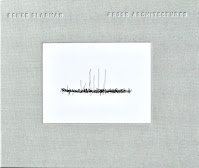Renee Gladman's Calamities was published by Wave Books in 2016. As I discussed in my previous post, much of what I found most interesting about Calamities was Gladman's thinking and writing about the relationship between the line in drawing and the line in writing. In 2017 Gladman followed up Calamities with a book entitled Prose Architectures, a series of 107 drawings which documented her subsequent investigation of the possibilities inherent in the nature of the line. In her introduction to the book, she says,
Having had no previous training in visual art, no apparent aptitude for it, I drew from instinct. Or better: I drew out of the matter that was most central to my thinking and living, and that was the city. It seemed the shapes I most wanted to represent or I most could represent were buildings. I don't remember setting out with any particular goal in drawing but I do recall clearly feeling that, through drawing, I had discovered a new manner for thinking.
Following up on this discovery, Gladman in characteristic fashion put a
lot of time and energy into pursuing the implications of engaging in
this kind of thought process. She put pen to paper in a way as to
explore the possibilities of the line not simply as the representation of a
pre-existing thought, but as generative of "a new manner for thinking."
Here, for example, is drawing #30 in the sequence:
(Image used with permission of author.)
This is a drawing that invites me to keep looking at it. It consists essentially of four vertical structural elements, a grouping of line-based sculptures. Within those structures there are sub-components that echo one another, for example the "C" shape in the second column mirrored by the reverse "C" shape immediately to its right, echoed by a similar shape further up in the same column. The columns are all connected by single lines that suggest perhaps telephone wires running between buildings. There's an interplay between the upward thrust of the elongated major shapes and the horizontal movement of the shorter tiers within each vertical structure, which call to mind asemic writing. The fourth figure, over on the right, feels like an outgrowth, an offshoot, both a continuation of and a departure from what has gone before.
The drawing looks as if it might well have been composed in one line, moving from left to right, the pen never leaving the paper. There's clearly a logic to the construction, an aesthetically pleasing unity and balance and coherence. But it is in no sense a paraphrasable logic. This drawing is not a re-presentation of anything. It is, like all the others in this book, a world unto itself. Alexis Almeida, writing in an essay on Tripwire about the drawings in Prose Architectures, puts it eloquently:
What attracts me most [about] them, then, isn’t any immediately discernable reading, but rather the proximities they create around me: the lines being extended between body and syntax, diagram and utterance, writing, mark-making, and physicality. When Gladman says they are a way “pulling the process of thought apart,” she is also re-imagining the way we can inhabit space, and thought itself, the way we might reconfigure the most familiar social and political structures, as well as how we can position ourselves within them, so that different relational possibilities begin to appear over time.
These drawings are thus the visible evidence of a certain kind of attention being paid by the artist over an extended period of time to the defining questions about the artistic process: What are we doing when we write? What are we doing when we draw? What are we doing when we speak out loud? When are we doing when we make music?
(For fuller overview of the nature of the drawings in the book, check out this video, a link to which is also posted on Gladman's web site.)
Gladman's work demonstrates that often in artmaking we are in essence pushing a line (of letters in sequence, of ink on paper, of sounds from within us) into an empty space: paper, canvas, silence. Much of the time, of course, we do these things more or less automatically and unreflectively. But over the years I have come to have a lot of respect for those writers and artists and musicians who investigate with attentiveness and thoughtfulness the ways in which the very act of writing or drawing can lead us in unexpected ways nearer to clarity and truth and beauty.
Each of the drawings in Prose Architectures is the product of a certain interrogative disposition, arising out of a focused curiosity: What would happen if...? They are part of a longer trajectory of examination represented by the entire body of Gladman's published work, about which I will have more to say in my next post.












No comments:
Post a Comment